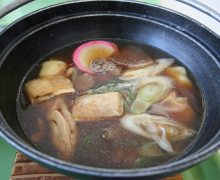Hittsumi
What is Hittumi?

Hittsumi
Hittsumi (ひっつみ) is,
a dish made by kneading flour with water, letting it rest for a little while, then pinching it with the hands to form flat, bite-sized dumplings, and stewing it in a broth containing vegetables, mushrooms, meat, and other ingredients. It is a type of suiton. It is a traditional local dish eaten in Aomori, Iwate, Miyagi, and other areas in the Tohoku region, and there are many variations in the ingredients and seasonings used, depending on the region and household.
Depending on the region, it is also called “hittsumi-jiru”, “totte-nage”, “tsumeri,” and so on.
Origin of the name Hitsumi
The name “hittsumi” is said to have originated from the dialect word “hittsumu,” which means “to pull” or “to stretch” the dough made from flour and put it into a pot.
Ingredients used for Hittsumi
Ingredients used for hittsumi include vegetables and root vegetables such as Japanese leeks, carrots, radishes, and burdocks; wild vegetables such as mitsuba, bracken, mizu, Japanese parsley, and urei; mushrooms such as maitake, shimeji, and shiitake; meat such as chicken and pork; river fish such as char and sweetfish, and seafood such as Pacific saury; konjak and deep-fried tofu. Konyaku, fried bean curd, etc. are used.
In some regions, mokuzu crab (Mitten crab) is used (crab hittsumi, river crab hittsumi), and other traditional cooking methods and recipes are handed down from region to region and family to family.
→ Suiton

Hittsumi(Sannohe Town, Aomori)























